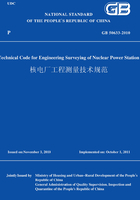
2 Terms
2.0.1 Nuclear safety
The achievement of proper operating conditions,prevention of accidents or mitigation of accident consequences,resulting in protection of workers,the public and the environment from undue radiation hazards.
2.0.2 Safety system
A system important to safety,provided to ensure the safe shutdown of the reactor or the residual heat removal from the core,or to limit the consequences of anticipated operational occurrences and design basis accidents.
2.0.3 Design basis
The range of conditions and events taken explicitly into account in the design of a facility,according to established criteria,such that the facility can withstand them without exceeding authorized limits by the planned operation of safety systems.
2.0.4 Deterministic method
A method by which most parameters and their values can be determined mathematically and explained by means of physical correlations.
2.0.5 Probabilistic method
A method using probability distribution models to analyze the sequence of hydrologic features to derive design parameters.
2.0.6 Design basis flood
The flood selected to determine the design basis of a nuclear power plant.
2.0.7 Residual heat
The sum of the heat originating from radioactive decay and shutdown fission and the heat stored in reactor related structures and in heat transport media.
2.0.8 Final heat sink
Air,or water body,or a combination of both,which takes the residual heat from a nuclear power plant.
2.0.9 Hydrologic survey
Activities that are carried out to collect basic hydrologic data,including field data collection,reconnaissance,investigation,survey and activities alike.